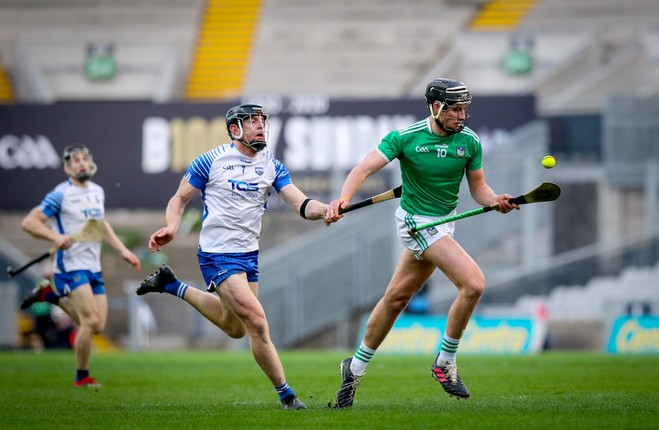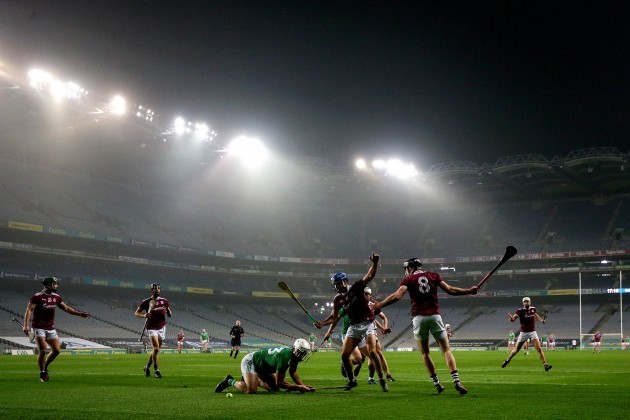THE LAUNCH OF the GAA’s 2021 inter-county roadmap gave managers something they’d been craving for months — certainty.
While four football counties have already been reprimanded for an early return to training over the last few months, inter-county sides can officially resume collective sessions next Monday.
The Allianz Hurling League begins on the weekend of 8/9 May, giving Division 1 and 2 sides just three weeks of preparation time together before the competitive games arrive.
From there, the matches will arrive thick and fast.
Top tier hurling sides will play five league games in six weeks. Two weeks after that, the Leinster and Munster championships kick-off.
Much like last season, the condensed nature of the campaign brings its own challenges from a physical perspective.
The hindsight gleaned from 2020, when the Limerick hurlers downed tools for a six-week period and individually completed eight-week speed work programmes before they returned to collective training in the autumn, has been valuable as the new season looms.
Asked for the biggest takeaway in terms of physical preparation from last year, Treaty strength and conditioning coach Mikey Kiely believes inter-county pre-seasons have tended to go on for too long in the past.
“It’s something I’d have thought about before, but we definitely don’t need the long pre-seasons we’ve had in previous years,” he tells The42.
“You’d have a lot of teams that go back in November, December for a league that starts at the end of January or February.
“I’m quite confident on it, and it worked out well last year, I would hope that we’ll optimise use of our time as well this year. A six-week pre-season is more than ample for professional players and that’s what we see ourselves as.
“It would be the same in soccer or rugby where players are contracted. They wouldn’t have the extended pre-seasons we have in the GAA. One learning is that I don’t think we need all the time we generally use to prepare. Particularly now that clubs are enhancing their professionalism as well.”
Kiely took a ‘less is more’ approach last summer to help prevent the Limerick players from burning out as they headed into a long club and county season.
The reigning league, Munster and All-Ireland champions took another lengthy break following the conclusion of the campaign last December.
Setanta and LIT S&C graduate Kiely believes the time off will stand to them this season.
“We’d have thought a long break would help us,” he says.
“Because these lads have won multiple underage and senior All-Irelands so getting that time to switch off, spend it with their families, concentrate on work and exams is important at that time.
“When we get back in season it’s more difficult to dedicate time to those things and that life balance is important for us – that they are succeeding at life outside of hurling as well.
“We’ve only one or two blocks of training done but we’ve enough done that we still think we’ll be in pretty good shape in the league and at peak form come championship time.”
While their recent Liam MacCarthy Cup triumph took place in the depths of winter, this year’s championship will return to the summer months.
The harder ground may lead to more injuries but Kiely believes it will suit a powerful side like Limerick.
“We were going from hard ground to soft ground going into the winter last year and soft ground is definitely more forgiving, particularly when you’re at top speed.
“For our players, we’d think they’re quite powerful and the hard ground will definitely benefit us in that we can produce and get greater returns from a stiffer surface.”
Kiely, who replaced Joe O’Connor as Limerick’s S&C lead ahead of the 2020 season, says educating the players for the reason behind such decisions helps increase buy-in among the squad.
“When you’ve had success it’s easier relay the message because there’s trust in the process. If we had got knocked out in the first round or two of championship, I can relate to some S&C coaches that might feel the need to go back earlier.
“It’s dependent on your own situation. Certainly we felt that an extended break would do them well. We just try keep education to the fore all the time. There’s no decision we make that we don’t provide rationale around.
“Because if the players aren’t educated around your decision making and the process, it’s going to inhibit buy-in. So definitely education is to the fore in terms of why we choose the decisions we do as a coaching team.”
When the first lockdown hit last year, Limerick ‘borrowed, begged and stole weights’ to ensure each player had at least a dumbbell, a barbell with some light plates to try and maintain their gym training.
In the time since, a number of players have put together their own home gyms. Kiely sees it as an example of the growing value modern players place on strength and conditioning.
“I think that’s across sports now. There’s more emphasis put on the physical preparation. That’s not to take away from the psychosocial or technical development but people understand the body better and we’re training for it.
“A lot of our players went away and invested their own money in gym equipment, and we see across the board players engage more with you on how to develop their own performance from a physiological standpoint.
“There’s a greater knowledge which has led to a greater interest from both players and management.”
One player who has massively bought into the S&C side of things is Hurler of the Year Gearoid Hegarty. Earlier this year the 6’5 half-forward recalled taking part in a gym session with the Limerick footballers aged 19 back in 2014.
“We had a strength test in the old building in UL,” said Hegarty. “You had to bench three-quarters of your body weight. Garrett Noonan was in front of me. Garrett was the same weight as me. He got down and did 25 reps at 70kg.
“I had hardly any gym work done at that stage of my life. I said, ‘Jesus, this can’t be too bad’. I got down and I couldn’t even lift the bar. It is something I’ll never ever forget as long as I live. I was never so embarrassed. I swore to myself that will never happen again.”
Seven years on Hegarty has developed into one of the finest athletes in the game. Kiely has witnessed his transition first hand, having been involved with the Limerick footballers under John Brudair during Hegarty’s time on the panel.
“It’s my second time working with Gearoid because I had him with the footballers in 2014 and 2015,” says Kiely.
“He has spoken about his immaturity as an athlete back then and how he’s matured since then. So I’ve seen that full development. What’s been big for him is that cardiovascularly he always had great scope in that he was playing games and training all the time in both football and hurling.
“What’s helped him massively in the last couple of years is he’s had time to recover. During his college period he was playing Fitzgibbon, Sigerson, inter-county hurling and football, plus hurling and football with his club.
“So he had very little time for strength training or recovery. I think both the strength training and recovery in the last year or two have really enhanced his game in addition to his technical development on the hurling pitch.
“Gearoid has always bought into it, he was always motivated to improve himself. It was just literally a time thing with Geaorid in that he was being pulled and dragged.
“He was talented in both sports and everyone wanted a piece of him so he never really got to dedicate the time to the aspects of training that are now very important in strength and power. Now that he has that time he’s really flourishing from it.
“And while I say he’s focusing on one sport now, the multi-sport approach in his youth has definitely allowed him to express himself optimally on the hurling pitch.”
*****
Over the past number of years, Setanta College has had a direct impact on the numbers of GAA players undertaking strength and conditioning. More and more GAA players are recognising the value strength and conditioning plays in their training to have them at peak performance. Setanta College are an education partner with the GPA and the WPGA, providing scholarships and discounts to members. This connection has led to close to 150 members who are either currently studying or have graduated from Setanta’s programmes.



